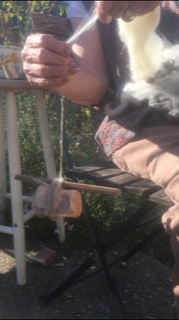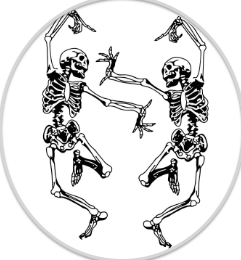Meetings of the Material and Immaterial
A lot of ecosomatic practitioners, myself included, can have a tendency to study the immaterial arts, such as dance. While the body is fleshly, mineral, and liquid material, a dance is itself ephemeral. It may leave imprints upon the place of occurrence, but the dance itself does not end up as something tangible you can hold and give to someone else to touch. It can be felt, but not touched, exactly. As I discussed in this podcast episode, some of my ecosomatic inspirations come from Butoh dance training and practices of “resonating with qualia,” which I would consider to be an immaterial and somewhat spiritual practice, though surely somatic.
Lately, though, I’ve been thinking more about the material arts, especially earth skills, handcrafts, and plant tending. I think about hands like a spider spinning thread from the most beautiful camel hair or cotton; I think about bending and squatting in a piedmont prairie collecting seeds and smelling leaves to help remember which plant is which; I think about cracking hazelnuts and carving wood. Some of these skills are really new to me and not yet actual skills; I am so grateful to Lyrra Magda and Louise Wheatley for introducing me to the art of making and using a drop spindle for processing fiber, to Lyrra for introducing me to the dismemberment arts and working towards understanding hide tanning (also for always teaching me something new about wild plants), and to Taylor of Wild Altar Farmstead for teaching me about wet felting wool and for geeking out with me about deepening relationships with place through action and art. I am also grateful for the Native Plants Nursery crew at Farfields Farm, as we all help each other grow in our understanding of local genotype plants and plant communities. And encouraging each other in all sorts of strange propagation experiments.
Feeling into these material arts, I become aware of the immaterial realms which are also always present. Louise talks about spinning as a settling activity; I feel this in my nervous system. Even though I am an extremely clunky beginner, I can taste little glimmers of a shift in state-of-being, as inner landscape merges with the material, mind simultaneously focusing and expanding, hands knowing the fibers and proteins in all their chaos and pattern. Louise talks about the medicinal quality of plants imbued in the plant dyes she uses in her fabrics, and it’s so lovely to imagine the body or a room being enveloped in that spirit…the immaterial dwelling continuously through the material. She talks also of a dream, myth, or story being woven into a tapestry. I am humbled by these masters of the material arts and how they create things that can touch and be touched physically and psychically. Created through hands and hand-tools rather than through machines, the pieces become artifacts of both individual uniqueness as well as the spirits of everyone whose materials are literally woven into the process.

Wool, carders, spindle 
Louise spinning wool using a simple rock and stick
I recall the first roadkill deer Lyrra taught me how to process earlier this year. I wrote dazedly in my journal: “No creature’s blood has ever covered my hands like this…effortlessly painting my skin, spirit permeating. This moment will live forever in my body as a bow of reverence.” There was such somatic dynamism in the process, a mix of tenderness and gentleness with snaps, jabs, saws, and tears. I am absorbing anatomical information I could never learn from a textbook. This one was a “trial by fire,” Lyrra said, as the wind blew a putrid gust from the deer’s anus straight into my breathing mouth. “Glorious, taut, graceful, pearlescent fascia; translucent threads of connectivity.” This seems like a kind of Death Bodywork, or perhaps ecological Death Doula-ing. Reverence is truly the best word for it. Later, we work more intensively with the hide…lots and lots of scraping, soaking, swelling, shaping, and membrane alchemy. I am tentatively dabbling in this art, again in awe of the embodied wisdom of the humans who do this for a living.
I’ve been gently adding native perennials to the woodland and meadows where I live, scattering pawpaw and milkweed seeds, and imagining into how this landscape will change in the coming years, and what actions I could take that would be genuinely beneficial for various species. I’ve pulled up some bittersweet, but only in small amounts, conscious of the reverberating impacts, questioning motives and outcomes. I contemplate the ecological roles of thickets and brambles. I have learned to wear shoes more often because of thorns. A friend points out signs of stormwater erosion on the creek bank and talks to me about how noticing which species of Solidago are growing gives clues about the geological history of a place.

The practice of understanding a plant and ecosystem well enough to clearly imagine the future and past generations (“To See a World in a Grain of Sand,” if you will) seems like an art to me, an art probably well-honed by indigenous people of this region and an art in which I am still a humble and flawed beginner. There is an immaterial aspect of landscape design that involves a visionary capability plus an understanding of the sovereign spirits of each of the beings of a place; yet the practice is rooted in the materiality of biology, geology, and botany. But perhaps in a non-westernized non-colonialist-influenced body and perceptual vessel, there would not really be any discernible split between material and immaterial.
Planting tiny groundnut (hopniss, Apios americana) rootstalks and vines, I offer them blessings for their new place. I feel the cold autumn soil on my fingers. The vines are starting to die back and I hope the little tubers have enough energy for the winter. I don’t know if my timing is right but I am trying. Perhaps we can make a home here together, caring for one another, listening, feeding, touching; cycling through living and dying.
“Enter, oh, enter the language of your skins,
where motion mentions silence, and words spill light
over the actual air; let your touch begin
spinning separate souls in one open flight
towards one believed delight.”
Annie Finch, “A Wedding on Earth”
